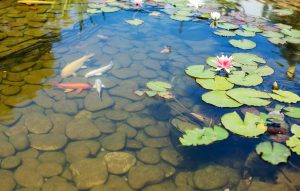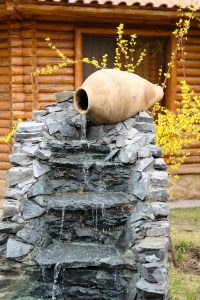Water Features: Which is right for you?
Water Features
Just because you live in a desert environment doesn’t mean you can’t enjoy the benefits of a water feature incorporated into your landscape design. There are a wide variety of factors that need to be considered before you decide on the right one though. These include usage plans, environmental features, and more. We’ll help you work your way through them, separate your needs from your wants, and determine which water feature is the right one for you.
Considerations to make when choosing a water feature.

There are some major considerations that need to be taken into account. This is especially true in a desert environment where a water feature will have to be fed on the grid and water prices can be especially expensive. Consider the following:
- Purpose – This should be your primary consideration. The purpose of your water feature will determine where you position it, the scope of it, and what short cuts you may be able to take to reduce water usage. Some of the reasons home owners decide on water features are for:
- As a decorative element in the front or backyard of a home.
- As a central focus point for relaxing or socializing
- As a way to attract wildlife and create a miniature oasis.
- As a multi-functional area for swimming and one of the above.
- Build Cost – Setting a budget is important. You don’t want to overextend during building. Taking DIY approach to certain aspects of a project can certainly cut this number down. Having a concrete idea of the average cost of your project in relation to the scope you are planning on can definitely help you keep costs within budget. This can also help you determine the scope of your project. After considering costs you may find a different option more to your liking.
- Ongoing Cost – Ongoing costs include the cost of water to keep your feature running, the cost of maintenance, and the cost of repairs. Some water features are more prone to damage over time. Others require regular maintenance in order to maintain the proper PH balances. Some home owners also opt for water features they can easily stop using during times where water prices may be excessively high.
Different water features and their associated costs, benefits, and disadvantages.
Fountains
Fountains can provide you with a great centerpiece or accent. These are often used in the front yard, and water usage can vary greatly depending on the fountain. This can make it an economical choice or increase ongoing usage fees if your chosen model uses a great deal of water. One of the great things about fountains is the sheer variety. Whether you want a small piece or a major central focus you can really tailor a fountain to your property and individual taste.
Cost : The average cost of a fountain is roughly $2,500. This can reach upwards of $7,000 depending on the design materials, how elaborate the fountain is, and more.
Advantages – A major advantage of fountains is tailored water usage. If you buy the right type of fountain it can also stand alone as an art object. If water prices become to elevated or your area suffers a drought you can turn off the water supply and still have a gorgeous statuary in its place. Fountains like bird baths can also be used to attract wildlife.
Disadvantages – Ongoing water costs never end but can be minimized by design. Fountains also need plumbing and electricity. This can elevate the cost substantially depending on the scope of the work. A landscaping company can help you minimize this cost by positioning a fountain closest to existing water and electricity lines.
Ponds
Ponds do more for a backyard than just providing a great focal point—they act as a relaxing area for socializing or just enjoying the great weather. These are typically positioned in backyards and may incorporate a number of additional features. These can include fountains and waterfall as well as fish and plants. Adding a living ecosystem into your backyard can be a great way to expand upon and experience nature. The cost of a pond can quickly add up though.
Cost : Cost varies depending on the size and features. A small 4×6 foot pond could cost as little as $2,500 dollars. Larger ponds with more features can range anywhere from $16,000 to 30 or 40 thousand dollars.
Advantages – Ponds allow for a great variety in differences. How you choose to decorate them and populate them with plant life can determine what species and variety of insects and animals you can attract. This can be really fun and interesting. Choosing which species you’ll attract can help you to create a unique biome in the desert. They can also create a relaxing safe haven so you always have a vacation spot nearby.
Disadvantages – Water sources can attract some unwanted guests as well. This includes a large variety of native scorpions. You’ll also want to consider the ongoing cost of a pond. If the pump is damaged you’ll need to repair it. Desert ponds also require a consistent source of water as well as filtration. It’s likely you’ll want to pay an expert to check the PH and nutrient levels of your pond on a regular basis or learn how to do so yourself. They also cannot function without water as a standalone piece.
Water Falls

Waterfalls come in two types. They can be integrated with pond features, but homeowners can also get standalone waterfalls. These cycle back into themselves and provide the sounds of waterfalls and babbling brooks without the water usage requirements of ponds. Choosing the right option depends on whether you want a pond, or may want to expand your water feature in the future. They can also be integrated into swimming pools, providing a quiet but visually arresting addition.
Cost : Freestanding waterfalls vary from between $300 to $2,000 dollars or more. Custom waterfalls attached to ponds or pools can substantially expand that cost to reach as high as 15,000. This makes it up to the consumer to choose the materials and scope that works for their budget.
Advantages – These are heavily dependent on which type you choose. One of the best aspects of waterfalls is that they often include variable settings. You can tailor the intensity of the flow in order to achieve different effects. Depending on your use a water fall can be integrated into an art piece, another water feature, practical usage area like a pool, or as a standalone feature. This makes it incredibly versatile and an excellent option for nearly any property.
Disadvantages – Water falls come with a variety of extra monetary considerations. Because they require pumps, the larger the waterfall, the more pumps are necessary. These can easily increase electrical utilities on the pool by as much as 8 percent. You’ll also want to invest in appropriate lighting. This can really make a waterfall stand out at night. Maintenance, repairs, and replacements may be necessary for pumps over the years.
Shopping around!
After you’ve established your needs and desires for a water feature, it’s important to shop around. Costs can vary heavily, and a large consideration is materials. Companies will help you navigate these complexities and work to reduce costs while still providing you with the feature you’re looking for. Enjoy the weather, and make sure you do your homework before you get a new water feature.
